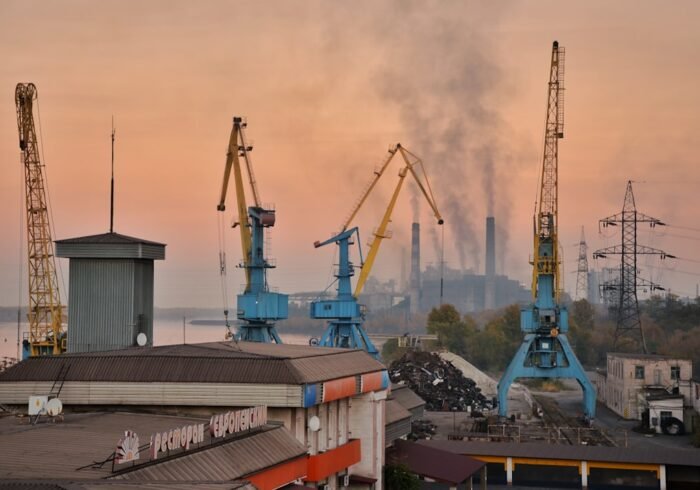One of the most urgent environmental problems of our day is deforestation, which is the widespread removal of trees from forested areas. Numerous factors, such as the growth of infrastructure, logging, urbanization, and agriculture, are responsible for this phenomenon. Wide-ranging effects of deforestation include harm to human societies, economies, and the environment. A series of ecological & social problems arise as a result of the disruption of the complex web of life that exists within forests due to their clearing. There are concerning statistics about deforestation. An estimated 10 million hectares of forest, the size of Iceland, are lost annually, according to the Food and Agriculture Organization (FAO).
Key Takeaways
- Deforestation is the clearing of trees and forests on a large scale, often for agricultural or industrial purposes.
- Loss of biodiversity is a direct result of deforestation, as it destroys habitats and disrupts ecosystems, leading to the extinction of plant and animal species.
- Climate change is exacerbated by deforestation, as trees absorb carbon dioxide and their removal contributes to increased greenhouse gas emissions.
- Soil erosion and degradation are consequences of deforestation, as tree roots help to hold soil in place and prevent erosion.
- Disruption of water cycles occurs when deforestation reduces the ability of forests to absorb and release water, leading to altered rainfall patterns and increased risk of flooding and droughts.
This decline is more than just a number; it signifies the devastation of innumerable species’ habitats, the atmospheric release of stored carbon dioxide, and the deterioration of essential ecosystem services. Creating effective plans to address this global issue requires an understanding of the complex effects of deforestation. The loss of biodiversity is among the most severe and immediate effects of deforestation. In addition to a wide variety of plants, animals, fungi, and microorganisms, over 80 percent of terrestrial species can be found in forests. These species lose their habitat when trees are cut down, which causes population decreases and, frequently, extinction.
According to the World Wildlife Fund (WWF), deforestation is a major contributing factor to the estimated 1 million species that are currently in danger of going extinct as a result of habitat loss. Ecosystem stability and resilience are significantly impacted by biodiversity loss.
A diverse forest, for example, can bounce back from a wildfire faster than a monoculture plantation. Also, biodiversity provides resources like food, medicine, and clean water, all of which are vital to human health.
Food insecurity & health crises can result from the disruption of these resources caused by species extinction. One major factor aggravating climate change is deforestation. During photosynthesis, trees take up carbon dioxide (CO2) from the atmosphere and store it in their biomass, acting as carbon sinks. The release of this stored carbon back into the atmosphere during forest clearing or burning contributes to global warming & the greenhouse effect.
| Impact of Deforestation on the Environment | Data/Metrics |
|---|---|
| Loss of Biodiversity | Over 80% of the world’s terrestrial biodiversity is found in forests, and deforestation leads to the loss of numerous plant and animal species. |
| Climate Change | Deforestation is responsible for about 15% of global greenhouse gas emissions, contributing to climate change and global warming. |
| Soil Erosion | Without tree roots to anchor the soil, deforested areas are prone to erosion, leading to loss of fertile land and increased sedimentation in water bodies. |
| Disruption of Water Cycle | Trees play a crucial role in regulating the water cycle, and deforestation can lead to altered rainfall patterns, reduced water quality, and increased risk of flooding. |
| Loss of Livelihoods | Many indigenous communities and local populations rely on forests for their livelihoods, and deforestation can lead to loss of traditional knowledge and economic opportunities. |
About 10–15% of greenhouse gas emissions worldwide are thought to be caused by deforestation, according to the Intergovernmental Panel on Climate Change (IPCC). Deforestation affects climate change in ways other than carbon emissions. By controlling precipitation and temperature, forests also affect regional and global weather patterns. For instance, regional rainfall patterns throughout South America are maintained in large part by the Amazon rainforest.
Reduced rainfall in this region due to deforestation may have an impact on millions of people’s access to water and agriculture. Deforestation urgently needs to be addressed as part of larger climate action plans because forests and climate systems are interconnected. Soil stability and health are greatly impacted when trees are cut down. By securing the soil in place, tree roots stop wind and water erosion. The loss of the protective cover that trees provide when forests are cleared increases soil erosion. Fertile topsoil, which is necessary for plant growth & agriculture, may be lost as a result of this erosion.
Soil degradation has become a serious problem that jeopardizes food security in areas where deforestation is widespread, such as parts of South America and Southeast Asia. Deforestation can also result in modifications to the nutrient availability & composition of the soil. Lack of tree cover can change the pH levels of the soil & lower its amount of organic matter, which lowers its farming productivity. Deforested areas are frequently left bare or desertified over time, making them unusable for natural regeneration or agriculture.
Local communities that depend on agriculture for their livelihoods are not the only ones impacted by this degradation; global food systems are also more broadly impacted. Forests are essential for controlling water cycles on a local and global scale. Transpiration is the process by which trees return water vapor to the atmosphere after absorbing rainfall through their leaves. Cloud formation and precipitation patterns are influenced by this process.
This natural cycle is upset when forests are cut down, which results in changed rainfall patterns & more drought or flooding events. Communities in areas with deforestation, like Southeast Asia or the Amazon basin, frequently encounter more severe weather occurrences. For example, regions that were once covered in forests may experience severe droughts as a result of less rainfall, while other regions may experience flooding as a result of heavy rains washing away unanchored soil.
In addition to harming ecosystems, the disturbance of water cycles presents serious problems for agriculture, the supply of drinking water, and the general resilience of communities. Globally, indigenous populations have long depended on forests for their identity, culture, and means of subsistence. These communities are directly threatened by deforestation because it destroys their ancestral lands and upends their customs. While meeting their needs, many indigenous peoples have created sustainable practices that preserve the health of forest ecosystems. These practices are frequently rendered obsolete, though, when forests are cut down for development or agriculture.
Indigenous communities’ reliance on biodiversity for food, medicine, and cultural practices is also impacted by the loss of forests. Deforestation jeopardizes these resources & threatens traditional knowledge systems, such as the many plant species used for medicinal purposes by indigenous groups in the Amazon. Also, the expansion of industrial operations into native lands frequently results in disputes over resources and land rights, which exacerbates social unrest and injustices.
Deforestation can have negative long-term economic effects, even though it is frequently motivated by short-term financial gains like logging profits or agricultural expansion. Ecosystem services, which are essential for maintaining economic stability, are reduced as a result of forest ecosystem degradation. For example, forests sustain fisheries, control climate, and supply clean water; their disappearance may raise the cost of disaster relief and water treatment.
Also, sectors like tourism that depend on thriving ecosystems may be severely harmed by deforestation. Many nations now rely heavily on ecotourism as a source of income, but as natural landscapes are destroyed, the allure of travel to these countries declines. As they struggle with the effects of environmental degradation, nations that place a higher priority on the short-term economic gains from deforestation may find themselves facing long-term economic difficulties. Governments, corporations, communities, and individuals must all work together to find sustainable solutions in order to combat deforestation. The application of sustainable forestry practices, which strike a balance between environmental preservation and economic demands, is one successful approach.
By guaranteeing that timber products originate from forests that are sustainably managed, certification schemes such as the Forest Stewardship Council (FSC) encourage responsible forest management. Initiatives for afforestation and reforestation are also essential in halting the effects of deforestation. In addition to aiding in ecosystem restoration, planting trees in deforested areas absorbs carbon dioxide from the atmosphere. By 2020, initiatives such as the Bonn Challenge seek to reforest 150 million hectares of degraded land.
Also, giving indigenous groups the authority to responsibly manage their lands may result in better conservation outcomes. Incorporating traditional ecological knowledge into land management practices and acknowledging land rights can improve biodiversity conservation while honoring cultural heritage. Lastly, increasing consumer awareness of the value of forests can increase demand for goods sourced sustainably. Through the selection of products certified by groups such as the Rainforest Alliance or the FSC, consumers can help preserve important ecosystems and promote ethical forestry practices.
To sum up, combating deforestation necessitates a thorough comprehension of its causes & effects as well as the encouragement of cooperation among diverse stakeholders in order to put into practice practical solutions that save our planet’s forests for coming generations.
Deforestation has a significant impact on global greenhouse gas emissions, contributing to climate change and air pollution. According to a related article on global greenhouse gas emissions, the destruction of forests releases carbon dioxide into the atmosphere, exacerbating the problem of climate change. To address this issue, it is imperative to focus on effective solutions for air pollution and climate change, such as reforestation efforts and sustainable land management practices. Reducing greenhouse gas emissions is a global imperative that requires immediate action to protect our planet’s future.



